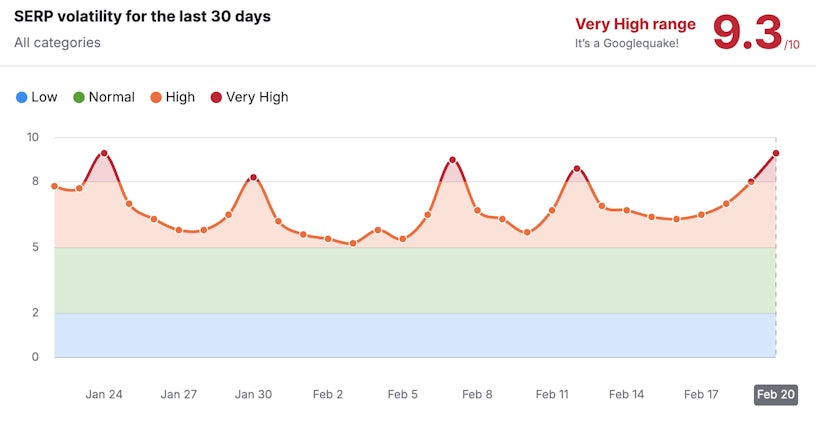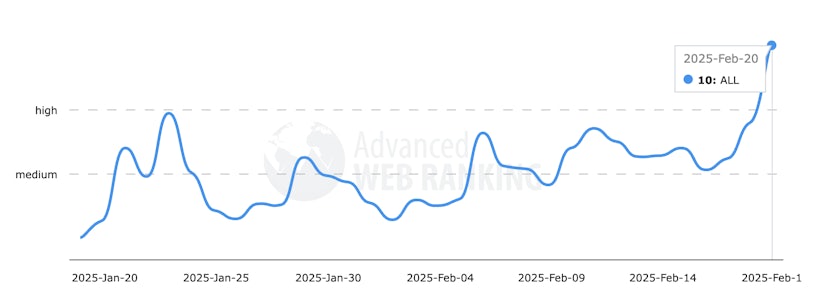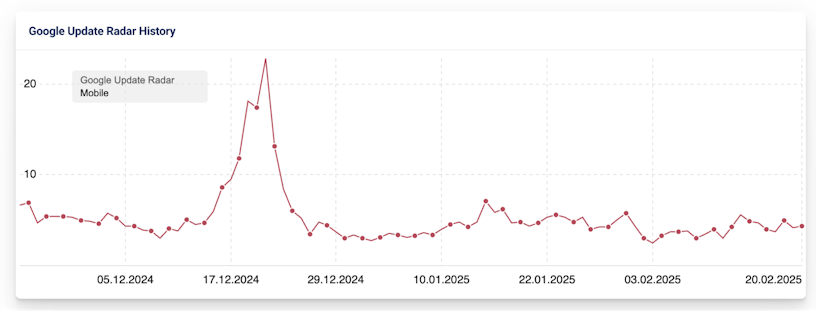This month, we bring you some exciting developments and updates from the world of search.
At the tail end of January and throughout February, search ranking volatility was reported on several occasions. Third-party tracking tools noted very high levels of SERP volatility around the 24th and 30th of January. Similar levels of volatility were also observed throughout February on the 7th, 12th, 20th, 26th and 27th.
AI Overviews were also the topic of conversation again this month, with SEO news outlets posting some interesting studies which highlighted the things you can focus on to capture these features and get your website cited.
This includes things such as creating interactive content which engages users and provides AI-friendly insights and also focusing on key SEO fundamentals such as building authority and creating content for every stage of the buyer journey.
Finally, a shift towards vector-based SEO is taking place as AI and large language models (LLMs) begin to prioritise content relevance, relationships and context over traditional keyword matching. This new approach, which is rooted in semantic SEO, uses vectors to represent words, phrases, and even images, allowing search engines to interpret user intent with greater accuracy and offering exciting new opportunities for content optimisation.
We’ll explore these updates and provide you with more details in the article below.
Allow our traffic light system to guide you to the articles that need your attention, so watch out for Red light updates as they’re major changes that will need you to take action, whereas amber updates may make you think and are definitely worth knowing but aren’t urgent. And finally, green light updates, which are great for your SEO and site knowledge but are less significant than others
Keen to know more about any of these changes and what they mean for your SEO? Get in touch or visit our SEO agency page to find out how we can help.
In this post, we’ll explore:
- Google search ranking volatility heating up Feb 20th, 26th & 27th
- Local SEO Schema: A complete guide to local structured data and rich results
- The importance of structured data
- Types of structured data that are essential for local SEO
- Structured data for AI search and voice search optimisation
- What sources do AI Search Engines cite? Analysis of 40k responses and 250k sources
- Key findings from the study
- Citation volume varies by engine
- Domain Authority (DA) matters
- Citation types and trends
- Buyer journey and citations
- Company size and citations
- UGC platform preferences by AI engines
- Why interactive content is key to AI-optimised search success
- Why interactive content outperforms static content
- How brands can leverage interactive content
- The shift to semantic SEO: What vectors mean for your strategy
- What does this mean for me?
- Google AIO is sending more traffic to YouTube
- Not appearing in Google AI Overviews significantly harms webpages
- Recommendations for brands
On 20th Feb, a significant spike in search ranking was recorded by some third-party tools.

Semrush Sensor data recorded a very high range of volatility on Feb 20.

Data from Advanced Web Rankings also showed a high record of volatility.
However, the data is mixed. For example, Sistrix did not show significant changes, and neither did SERPstat. These are unconfirmed updates and SEO chatter in the community.

It also heated up on the 26th and 27th of February, with the SEO community chatting about the ranking volatility. However, the third-party tracking tools currently seem relatively calm.
Since Google hasn’t officially confirmed any updates during this time, the reasons behind these fluctuations remain unclear.
Structured data is a key tool for improving a local business’s online visibility. This article from Search Engine Journal provides helpful tips on how you can implement schema to improve and refine your local SEO strategy to ensure that your visibility is maximised in local searches.
The importance of structured data
Structured data provides search engines with crucial information that helps them to better understand your content and how to display it in the search engine results pages (SERPs).
Implementing structured data is a powerful strategy that local businesses can use to improve visibility in both traditional search results and AI-driven tools. Utilising structured data increases your chances of featuring in rich results, which can further boost click-through rates.
By implementing schema markup, businesses can highlight critical information such as:
- Business hours that also reflect holiday opening times
- Customer reviews and ratings
- Location details with maps and directions
- Product pricing and availability
- Upcoming events and promotions
It’s important to note that structured data is not a direct ranking signal but rather a directive that helps search engines like Google better understand your content, which in turn can increase the likelihood of you appearing in rich results in the SERPs.
As an experienced local SEO agency, we help businesses to achieve their objectives in both the UK and internationally. Learn more about our local SEO services and how we can increase your local presence online.
Types of structured data that are essential for local SEO
With so many types of structured data available, it can be difficult to pinpoint exactly which ones will benefit your business the most. For local SEO, the following schema is highly recommended:
- LocalBusiness schema
- GeoCoordinates schema
- Event schema
It can also be beneficial for local businesses to consider including the following schema properties in their structured data:
- Name
- openingHours
- AggregateRating
- Logo
- SameAs (to link any social media accounts)
Structured data for AI search and voice search optimisation
As search engines evolve their platforms and how people search changes, implementing structured data has never been more important. Much like traditional search, incorporating structured data into your website provides crucial contextual information that AI platforms can use when delivering results to users who use voice search.
Similarly, structured data aids in voice search optimisation by providing search engines with accurate and concise information which can be answered through voice assistants like Alexa and Siri.
Check out our Local SEO guide to learn more about the fundamentals of local SEO. Alternatively, explore our local SEO services page to see how we can help.
A study carried out by xfunnel analysed 40,000 AI search responses and 250,000 citations across ChatGPT, Perplexity, and Google Gemini to reveal key insights into how AI search engines select and reference sources.
Key findings from the study
Citation volume varies by engine
- Perplexity ~6.61 citations per response
- Google Gemini: ~6.1 citations per response
- ChatGPT: ~2.62 citations per response (though evolving with deeper search integration)
Domain Authority (DA) matters
- High DA (80–100) sites dominate citations (~31.53%).
- Sites with moderate DA (20+) are well represented, while low DA (0–19) sites are rarely cited.
- Surprisingly, sites with a DA of 60-79 were cited less frequently than 20-59 DA sites.
Citation types and trends
- Earned media (third-party, affiliate, editorial sites) is the most common citation type.
- User-generated content (UGC) is increasing, with sources like Reddit, G2, Trustpilot, YouTube, and Medium appearing most frequently.
Buyer journey and citations
- Early stages (problem exploration, solution education): AI cites third-party sources (Earned).
- Mid stages (solution comparison): More UGC, indicating demand for reviews.
- Final stages (solution evaluation): Higher citations of brand and competitor sources for more detailed product information.
Company size and citations
- Larger companies (50,000+ employees) see their sites referenced more frequently in AI search results.
UGC platform preferences by AI engines
- Perplexity appears to favour YouTube and PeerSpot.
- Gemini mostly includes content from Medium, Reddit and YouTube.
- ChatGPT tends to mention LinkedIn, G2 and Gartner Peer Reviews over others.
This study offers valuable insights for marketers and SEOs on how to influence their brand’s presence in AI search results. Notably hard to track, AIOs present both challenges and opportunities for brands to increase their visibility on the search results pages (SERPs).
To increase their visibility and capture more SERP real estate, brands should consider several key SEO fundamentals. These include obtaining backlinks to build website authority, developing content that is tailored to each stage of the marketing funnel, and adhering to technical SEO best practices.
To learn more, explore our guide to Google’s AI Overviews to learn more about this generative AI search results feature and get tips on how to optimise your content for them.
Why interactive content is key to AI-optimised search success

The shift of generative AI and AI-generated answers presents a new opportunity for brands to be included in AI-driven responses. Still, success requires creating interactive content that engages users and aligns with AI-friendly insights. Examples include:
- Quizzes – Short, engaging assessments that help users find answers relevant to their concerns.
- Digital Tools – Calculators and structured guides offering actionable insights, such as home financing tools or sports field replacement costs.
- Downloadable Resources – PDFs and guides presented in list-based formats with trending headers to enhance readability and AI indexing.
Why interactive content outperforms static content
Traditional long-form content is static, offering the same experience to all users. In contrast, interactive content personalises engagement, encouraging exploration and deepening user relationships. Chatbots, explainer videos, and animated infographics enhance engagement by addressing customer knowledge gaps.
Generative AI prioritises content that demonstrates direct experience, breaks down definitions, and provides structured “how-to” steps that are best suited for interactive content. This enhances AI search rankings and increases conversions through email sign-ups, form submissions, and calls.
How brands can leverage interactive content
By embedding interactive tools, brands can strengthen authority, enhance AI search visibility, and drive user engagement in an evolving digital landscape.
- Ask “how” – Structure content to answer conversational queries clearly and directly.
- Use direct experience – AI favours content tailored to users’ needs, making firsthand insights crucial.
- Test continuously – Analyse high-performing content to refine strategies for AI search.
The article from Search Engine Land discusses the evolution of SEO with the rise of vector-based search driven by AI and large language models (LLMs).
Unlike traditional SEO, which focuses on exact keyword matching through keyword research, vector-based SEO optimises content based on meaning, relationships, and context. Vectors are mathematical representations of words, phrases, and even images that AI uses to understand content in a more sophisticated way, allowing it to interpret user intent more accurately.
The shift to vector-based SEO means that websites need to optimise for relevance, not just specific keywords. Search engines now consider semantic relationships and interpret intent, so even if a query doesn’t contain exact terms, AI can still find the most relevant content.
This change also allows AI to interpret non-text content, like images, videos, and voice search.
What does this mean for me?
To adapt, SEOs should focus on:
- Content Strategy and Keyword Research: Use AI tools to analyse competitors and identify semantically related topics.
- Content Optimisation: Align content with search intent and user queries, not just keywords.
- Performance Forecasting: Use AI to predict content performance and prioritise updates.
Despite these changes, traditional SEO principles like high-quality, intent-driven content, structured data, and a clear internal link strategy still matter. The article concludes by emphasising that those who adapt to AI-driven SEO early will have a significant advantage in shaping the future of digital marketing.
In a recent study conducted by BrightEdge, they looked into the growing impact that YouTube has on AI Overviews.
According to BrightEdge data, YouTube’s presence in AIO has seen substantial month-over-month growth, with a 21% increase from the 1st of January and a 36.66% growth from January to February 2025.
Certain topics are benefitting more from this shift. A significant portion of AIO’s citations for YouTube comes from instructional content (31.2%), including how-to queries (22.4%) and visual demonstrations (28.5%). Product comparisons and current events also contribute, though to a lesser extent.
Industries like healthcare and eCommerce are seeing the most benefit from AIO, driving traffic to video content, with healthcare leading at 41.97%. On the other hand, sectors like education contribute less than 4%.
This data suggests a shift in Google’s AIO strategy and shows how emphasis is being placed on the inclusion of video content, particularly for instructional, visual and demonstration-focused results.
The takeaway for content creators is to prioritise creating videos around product demonstrations, step-by-step tutorials, and comparisons, as these formats seem to be gaining the most traction in AIO.
Not appearing in Google AI Overviews significantly harms webpages

A recent study by Terakeet has analysed the impact of Google’s AI Overviews on webpage traffic, revealing significant findings and indicating that relying solely on high SERP positions may no longer guarantee consistent traffic.
Positive Impact of Inclusion in AI Overviews:
- Top-ranked Transactional Queries: Webpages featured in AI Overviews experienced 3.2 times more clicks than those excluded.
- Lower-ranked Transactional Queries: Featured pages saw a 1.2-fold increase in clicks versus those without AI Overviews.
- Top-ranked Informational Queries: Pages included in AI Overviews received 1.5 times more clicks than those excluded.
- Lower-ranked Informational Queries: Inclusion led to a 1.1-fold increase in clicks compared to pages on SERPs without AI Overviews.
Impact Based on Query Intent:
- Informational Queries: AI Overviews diverted traffic from pages in positions 1-2 but increased traffic for those in positions 3-10.
- Transactional Queries: Regardless of position, pages included in AI Overviews benefited from increased traffic.
Recommendations for brands
- Optimise content to align with AI Overview criteria, increasing chances of inclusion.
- Regularly assess the impact of AI Overviews on your site’s traffic and adjust strategies accordingly.






